Material poetics describes the intersection of poetic expression with the use of material media, a conscious exploration of ways of working with materiality to extend or enhance meaning. The Greek poiesis is the act of making, of creation; to explore ‘poetics’ is to pay careful attention to the nature of an object or process. Each element is a language in itself, a visual and haptic mediator that is fully capable of influencing the reception of the text. Material poetics is thinking through every element of a work as a carrier of meaning.
Interlocutors: Caren Florance, Sarah Rice, Melinda Smith, Philip Gross
Question 1: How does matter matter in your work?
CF: Materiality has crept up on me over the years. I lived inside of books until my mid-twenties, when I stumbled upon a letterpress workshop. I realised that the words I looked at every day once had a solid existence, even if it was only a historical perspective. Holding letters—metal or wooden blocks—in my hand just opened a door in my head and I just had to get through to see what would happen.
Getting regular access to the process put me in the path of other material preoccupations, like artists’ books, printmaking, bookbinding, and sculpture. The more I work with these processes, the more I think about what they can bring to the words or meanings they are hosting. In my practice, I use visual materiality to extend the work of the words, and also the work of the ‘white’ space that supports their movement both on the page and in their reception (see Figure 1).
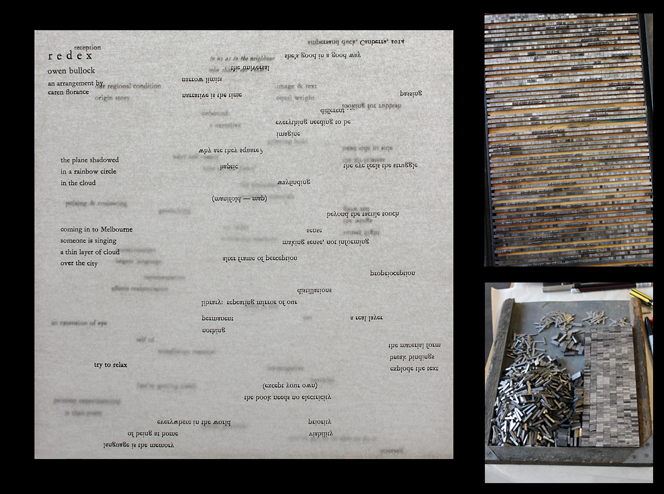
Figure 1: Caren Florance, redex, 2014. Poem by Owen Bullock Rice, arranged/reduced by CF. Letterpress on Whitetrace stock, 4pp ‘pagefold’ format. 207 x 205mm. Edition of 170, printed for Parentheses journal deluxe folio. Also in picture: [top right] the letterpress forme for the print, showing the constructed white space; [bottom right] the pile of blocks that made up the white ‘space’ in redex.
I wasn’t terribly interested in poetry before I learned letterpress, but for many reasons the two go together beautifully. Material bibliographer Jerome McGann (1991: 10) says that ‘The object of poetry is to display the textual condition. Poetry is a language that calls attention to itself, that takes its own textual activities as its ground subject.’ The more I printed ‘stable’ textual activity, the more I wanted to shake it up a bit, make it MORE active. Poetry is full of material references, and the challenge (for me, at least) is to try resist the comfort of materiality as ‘illustration’, but it’s sometimes a tough challenge.
SR: Matter matters to me on a number of different levels. First, words themselves have texture, edge, weight, taste. We feel them as we would a material object. This idea of the pleasure of the word like a cherry in the mouth to be rolled around the tongue is something I explore in many of my poems, for instance in ‘Speaking Bluntly’:
If words had a weave we would feel when our lover spoke
to us in hessian when we needed satin taffeta, and more subtle
vocal fibres, the inflection of cashmere over merino or mohair.
Secondly I am interested in the materiality of writing—the physical, embodied act of writing, for me, always with pencil and paper—and with an incapacity to ever reach the right hand margin of the blank page, like crossing the Nullabor: the white expanse, a desert of material presence writ as absence. The material qualities of my draft writing express more than the type-written word can—for instance how heavily I press my pencil onto the page indicates my level of surety, the faint words are hesitant, as yet uncertain. Angle, slant and margin all play their part—the words slide around loosely in this first instantiation before they are bedded down in type.
The third aspect of materiality I am interested in concerns the body—that is the material inspiration (breath) of the poem. I have already mentioned the physical act of writing, but perhaps more important for me is the physical act of composition—the pulse, the beat, the breath of the poem, often created mid-stride (literally) while wandering in the foothills of Mt Majura. This is also the way I memorise all my poems—make them part of my flesh, my material presence. It’s wonderful to me to think of a poem inhabiting my cells: ‘and your very flesh shall be a great poem’, says Whitman in the preface to Leaves of Grass (1868).
The final level on which matter matters for me and my work is the most straightforward and literal. That is, I am a visual artist as well as a poet and, as a poet, I often collaborate with visual artists such as print-makers, book-makers, ceramicists, glass-artists, photographers etc. In order to work with these artists I need to understand their material and what implications, limitations, possibilities will be opened up by and through this material. What associations and references are embedded within the material? What is its potential when combined with text?
MS: Even in the poems I write for the page, I think constantly about the text itself—the material through which the poem is transmitted—on the level of capitalisation, margin placement, line and stanza breaks, punctuation, use of italics and bolding, and intra-line spaces. As someone who uses a lot of poetic forms I use these material decisions to either emphasise or camouflage the poem’s formal skeleton.
I also have a significant performance strand to my work, and so the length of the breath, and repetitions and variations in rhythm, are another type of matter that I am very conscious of as I make poems.
When my poems appear in other media (as posters, wooden signs, photographic captions projected on a ceiling, sound recordings, and even choreography), each project throws up a new range of material questions to be resolved—considerations of colour, and size, and positioning, and lighting, and speed and mood and duration, to give some examples (see Figure 2). This adds an extra level of complexity to the making process but is incredibly important to get right. I also love the way that a poem in a different medium can encounter someone who was not expecting poetry, and capture their attention before their defences are up. My approach to material questions posed by a new medium tends to aim at enhancing this effect.
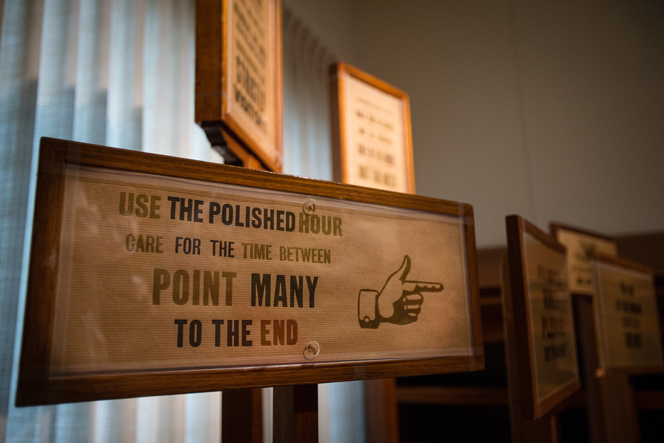
PG: On the question of materiality in the creative/composition process I have, as they say, ‘got real’. I'm not one of those writers who claims to write everything in his head and hold it there. I used to feel apologetic about that. Now I see that I need the tangible other space of a page for the words themselves to become ‘other’—to leave home-in-my-head and take on a life of their own, from which they can look back at me… and a conversation can begin between us.
My notebook is less book than compost heap, mulch, seedbed—full of scraps, false starts and fragments, sticky strands of words that gradually stick to others, an old curiosity shop in which all kinds of disregarded things might be found years later, or might link up with each other almost of their own accord.
This disorderliness is quite deliberate—resisting the other tendency I know I also have: to put ideas in a linear order; to make sense of it too soon. I turn the physical notebook this way and that, so entries stand at every angle to each other, with no order of first/last, top/bottom or priority.
The whole process, from first inkling to final transmission of the poem, takes place materially. The living poem is an experience, one we might compare to a soul, but ‘soul’ is another metaphor. (I say that as a Quaker who would call himself a materialist, in the philosophical sense.) Likewise the sense that, when we are feeling for the poem, it is ‘out there’ somewhere. In fact, it is ‘in there’, in the matter we work with… including the matter we are (i.e. ink, electrical circuitry, the hand that grips the pencil, the air in the larynx and lungs). It arises from the body (so our age and gender, states of health or nutrition, balance of hormones, point in the circadian or monthly rhythm… all of these make a difference).
Question 2: What does space mean to you?
CF: I work graphically with page space in a visual sense but with the consciousness of a writer (see Figure 3). Space, for me, is pause and effect. Printmakers tend to see the page (or the print, which is decorated page) as a surface, but that’s just one approach to it, an approach that works well with a single sheet. However, when you work with multiple sheets, folded or bound, page space becomes dimensional, sculptural and temporal. And that’s just the matrix. Add to this the affective quality of typeface, colour, texture and the words and images themselves, there’s a lot to think about. It can be overwhelming, so I tend to try to keep things visually simple and spacious.
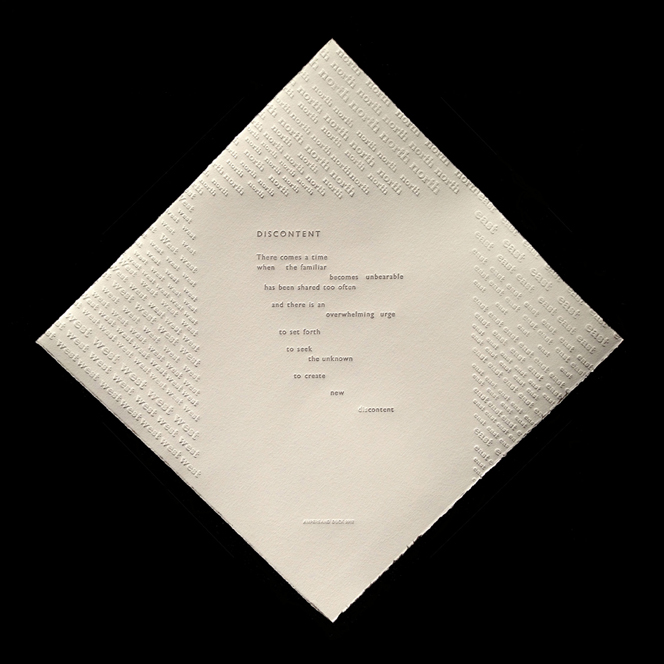
SR: Space is crucial to my work. I am more and more convinced that the blank, the void, the absent, unspoken, erased, forgotten, hidden, etc do more work than the words themselves. For instance John Cage (the infamous composer of 4 minutes 33 seconds of silence), inspired by Robert Rauschenberg’s equally infamous White Paintings, said ‘One day when I was studying with Schoenberg, he pointed out the eraser on his pencil and said, “This end is more important than the other.”’ The importance of cutting back is one thing, but of more interest to me is the concrete materiality of blanks, something I learned first and forcefully when Caren was typesetting my artist-book Those Who Travel (with prints by Patsy Payne, see Figure 4). I watched her run out of blanks due to my excessive use of lineation! I had never before thought that space takes up space—is concrete, a thing! From there I like to think along the lines of Glyn Maxwell (as explained beautifully in his On Poetry) that poets always work with two materials—black and white, sound and silence, something and nothing, life and death. It is very easy for an artist, of any variety, to focus only on the bit they brought into existence (the word, the sculpture, the pot etc) and forget entirely what was there before, or left out, or remains behind—the hollow space for instance that makes the bowl a bowl—that does all the holding.
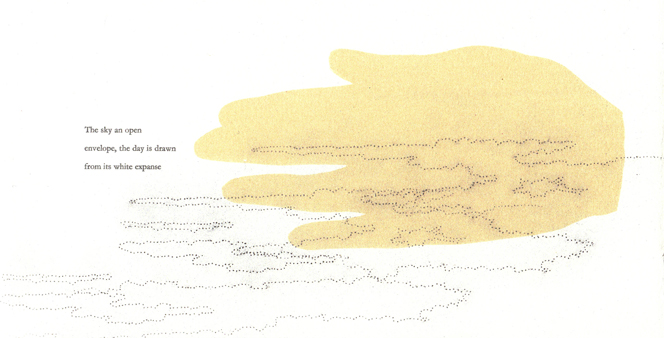
In terms of a concrete example, I often use indents and the tab bar in my poems, or a gap running down the middle of my poems. For instance in the following poem, ‘The Door in 4 Parts’, the vertical blank operates as more than a visual representation of a door left ajar—it enables me to move the poem (the words) around this silent axis (see Figure 5).
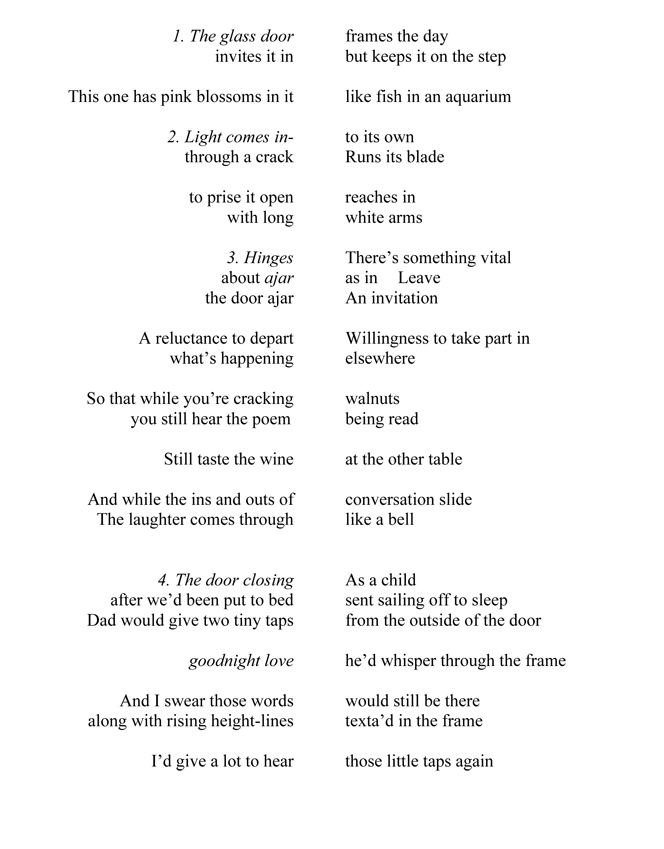
MS: Apart from the obvious line and stanza breaks, in my early work I did not pay much attention to gaps and absences. I had of course heard of John Cage but I saw no reason to repeat his thinking in my own work.
More recently I have been writing poems in which spaces within individual lines (in effect, exaggerated, oddly placed caesurae) contribute to meaning. One example is ‘Brain Weather’ (Figure 6), where the spaces enact glitches in neurological processing:
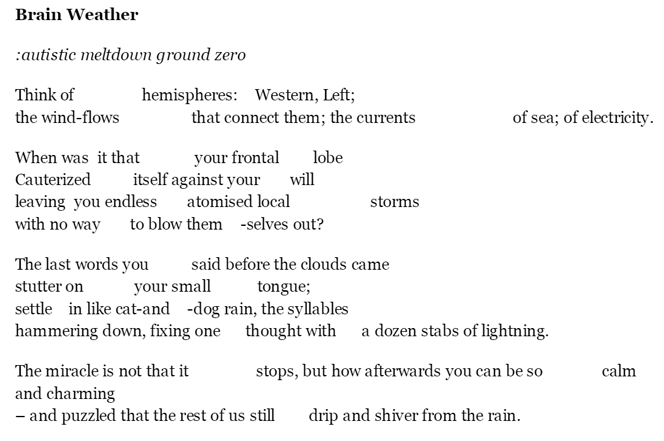
I have also used this kind of spacing to humorous effect, such as in ‘Wish you were here’ which explores a communication breakdown during a Skype call.
In performance, this spacing is reflected in physical pauses during the reading of the line.
PG: Almost as soon as I had the craft to write a ‘well-made poem’ I began to see the evocative, suggestive power of broken texts. At first, the white space on the page was simply the sea surrounding these islands, but gradually I began to see it, round the edges of the page and flowing into the text, as a part of the poem. I owe this partly to my growing sense, through Quaker meetings, of silence as potentially a positive presence, alive with clarity and new perspectives. It was not the antithesis of language but a part of it.
That sounds like a neat insight. Coming to terms with it has been a 60-year journey, and still under way. I started as a child with a stammer; silence was the enemy, the thing that stopped my breath and tied my larynx in a knot. Later, bit by bit, I’d see that this was only one of the many languages of silence, and a bad one at that. I met those Quaker silences; I felt the force of a well-judged line break in a piece of verse. I even came to re-evaluate the inwardness, the self-containment, of my father’s Estonian heritage. Paradoxically, the more I felt able to speak out and express what cried out to be said, the more I came to value the equal-and-opposite value: the unsaid.
These days the white space on the page is part of the architecture of a poem. It doesn’t simply equate with silence. It might equally/also be an almost tactile indication of how the dynamics of the voice, or the shifts of thought, flow. It is also a sign of, a reminder of, the active presence of ‘the space between’—between the elements in a poem, or between collaborators, or indeed between any two people in relationship. No surprise, then, that in the manuscript of my next collection, currently lying on my editor’s desk, there is a substantial set of poems called ‘Specific Instances of Silence’.
Question 3: How do you use technology and how does it affect your work?
CF: Johanna Drucker asked, ‘To what extent do technical and formal conventions or affordances of different media shape the way we understand what a poem could be?’ For me it’s all about the media, the technology, and what it’s physically able to do, and this forms a creative constraint. Poetry is then the testing ground to play and push and see what can be done within those constraints. It’s no use getting hand-set lead type to try to do what digital printing can do: it’s messy, and angular, and easily broken. Likewise, if working with digital media, what can it do that other processes can’t? This, for me, is material poetics: working out what the media can achieve that is the essence of its process, and then I use poetry, which is the essence of the literary, to utilise that process. I use poetry like other people use abstraction or jazz to explore painting processes or what an instrument can do. Sometimes a poem suggests a process (like letterpress, or video animation), and sometimes I look for words to help me explore the process I’m using at the time (see Figure 7).
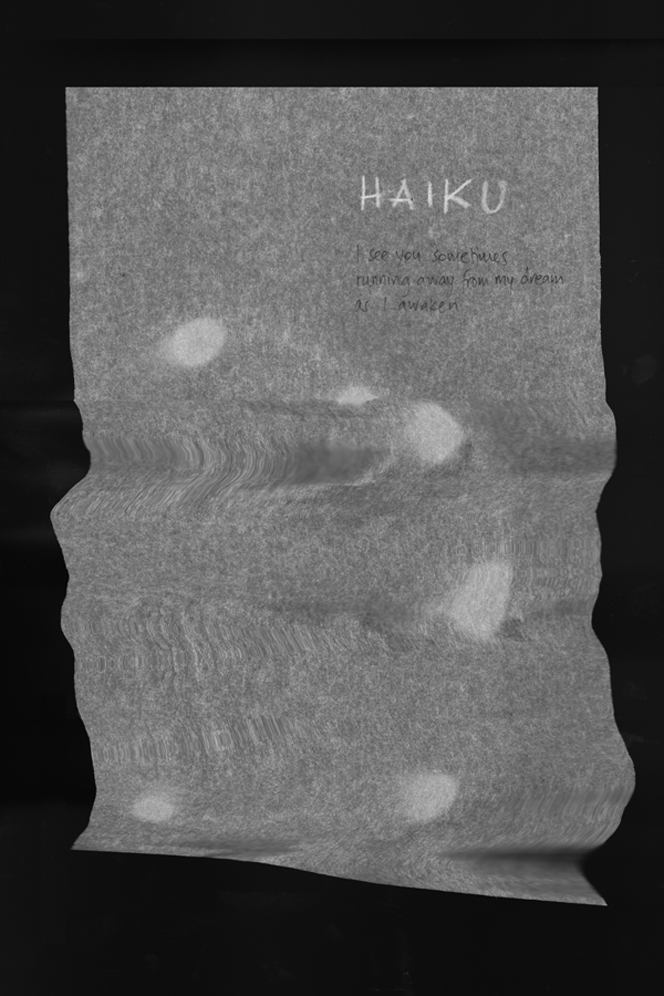
SR: I would probably have to admit at this point that I am a complete luddite—and a bit of a technophobe! As described in my answer to the first question, I work with ‘crafting’ pencil on paper. These are still of course ‘technologies’ of some description and have an effect on my end product—probably best exemplified by my collaboration with Caren on Vitreous Syneresis where she used my notes (with all their scribble and crossings out and edited marks) as a way of illustrating the meaning and message and ‘activity’ of the poem. The result is a work that leads the eye of the viewer to experience the eye floaters, light traces and black dots I am discussing in the poem (see Figure 8).
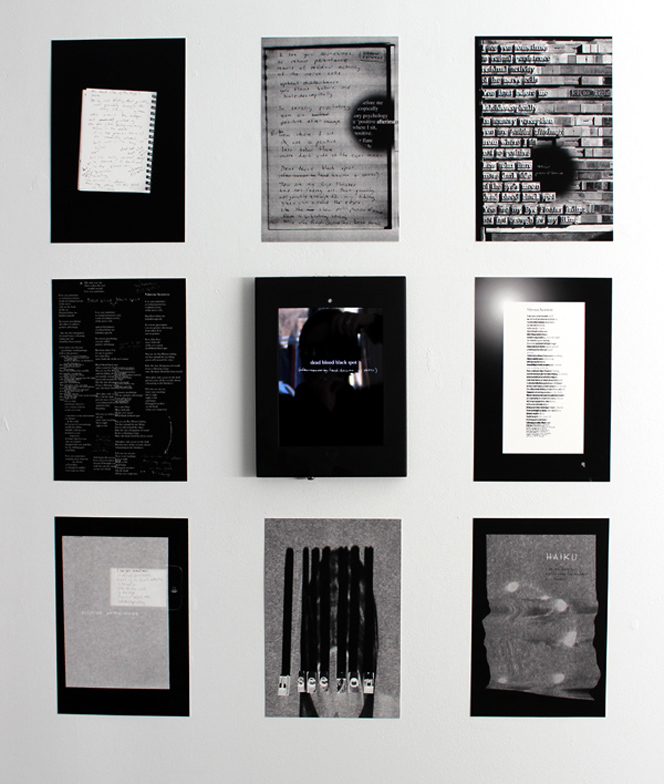
Figure 8: Vitreous Syneresis (I see you sometimes), 2014, in situ. Poem by Sarah Rice. Eight manipulated digital prints on archival rag paper and iPad animation. 200 x 300. Edition of 10.
MS: I use technology to assist in both poem creation and in poem dissemination. I think of each new tool as a new way of introducing creative disruption into poem-work. On the creation side, I have used the Internet Anagram Server (www.wordsmith.org/anagram) to make each line of a poem from the letters in a phrase such as ‘Autism Spectrum’ or ‘Decree Nisi’. Poems composed with tools like this are quite different to poems composed more traditionally, but I enjoy working with—and sometimes against—the mechanised flavour of material generated in this way. Sometimes it can be interesting to try and make the poem speak in an exaggeratedly emotional voice for example. I have even made (mostly for experimental purposes) a small, simple rule-based acrostic cento generator, which asks the user for an acrostic word and arranges pre-loaded lines of poetry based on which lines have an initial letter matching letters in the acrostic word. Sometimes the results are quite beautiful or interesting. Other times, not so much.
I have also used Twitter as a simultaneous composition tool (for the 140-character-limit) and means of dissemination. Twitter has had its own influence: in particular things like hashtags have begun to creep into my work. I’ve recently been experimenting with other dissemination platforms such as Instagram (check out @lookup.project) which is great for ekphrasis: the source work can appear as a picture with the poem as a ‘caption’.
PG: Everything I have said so far sounds very old-school, as if I am an entirely paper-based life form. Working with visual art and artists began to wean me away from that. The play with all kinds of material things (not only paper) in workshops is productive in itself, as well as being a tangible metaphor for some of the inner processes of poetry. In poetry/art workshops my wife Zélie and I have led over the years in schools and with adults we have sought out other material surfaces to write on, or used physical means of writing such as printing blocks for text that act as slowing mechanisms, noting the effects it has on people’s use of language (remember the original stone-inscribing sense of ‘lapidary’, a word now used for the most crisp and authoritative literary style?). This is not the only effect that slow-mo writing can explore, as you see in the image below (Figure 9).
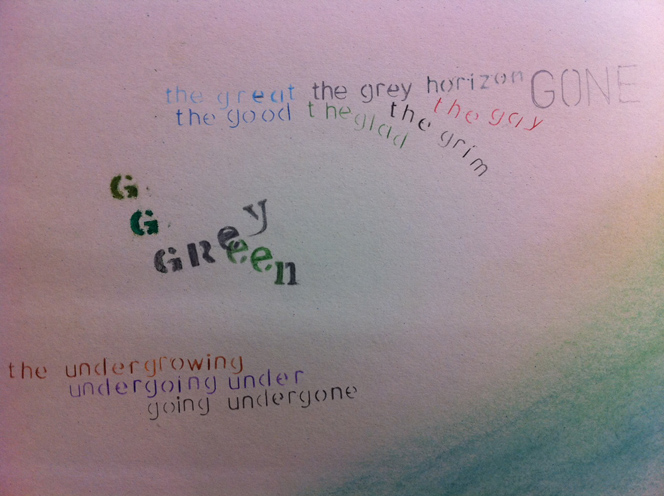
Sitting in on studio sessions with my collaborator in A Fold in the River, Valerie Coffin Price, produced some telling doodles on scrap paper (see Figure 10) as well as the poems-on-process that became text for the book. Sometimes that text was re-fragmented in Valerie's work with image transfer—sticking then peeling, rubbing and shredding away the original of an image in another case of eloquently ‘distressed’ material (see Figure 11).
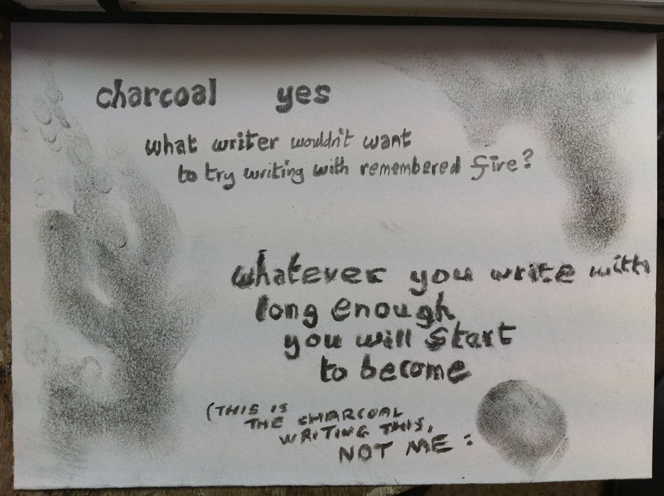
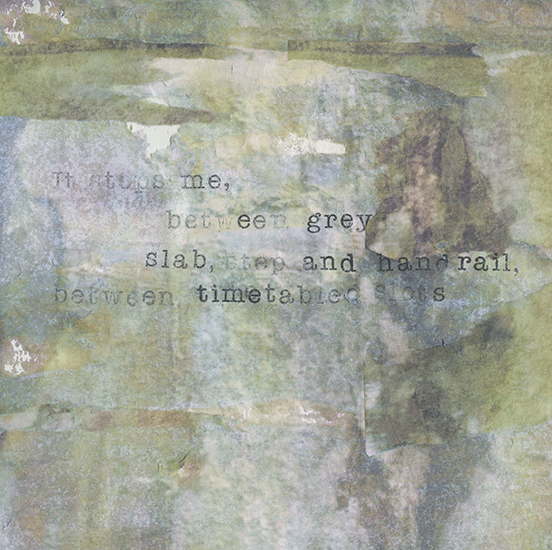
And how about the materiality of modern technology? (Not that a computer screen is any less ‘material’ than paper.) I resisted the iPhone for a long time, fearing that the electronic media I associated with the least creative sorts of work would invade the last free spaces in a busy life, like the half hour each day on the train between home and university. I took the risk. The result: the notepad space, one screen’s size, became a palpable thing, a tool, and suddenly there I was writing a rapid prose-poem to fit it… then another, then another… which started channelling what seemed an unfamiliar voice, resulting in a sequence of over 100 little prose poems. Unfamiliar, that is, until I recognised it as that of an imaginary Estonian writer in a novel I'd begun and which had foundered for the lack of a convincing way of speaking.
What had released it seemed to be another game of otherness: the ability to write in seconds and immediately email the draft to my other address, putting it out of sight, in storage, to be returned to some time later. The speed seemed as productive as the printing block’s slowness had been. Which leads to a question: is time, and speed, ‘material’ for writers, too?
Also I think the ease of spatial editing on any computer—to try and try layouts on the page so fast it almost isn’t conscious thinking—enabled something, too.
I suspect that if someone put me in a setting, probably in a collaboration, where treatment and editing of recorded voice and sound became a plastic medium I could play with… well, precisely: I would play. I suspect I would make things by those means which were quite different from written poems read out loud. Not instead of them—I can't imagine that—but as well. In a small way I see this in words I write to be made into visual or 3D objects. They aren’t just page-poems transposed.
Question 4: All of the participants in this panel either work in multiple art forms, or create work in response to work in other art forms, or collaborate with artists from other disciplines to produce work that spans multiple formats. What, for you, is so seductive about crossing media and disciplines?
CF: That’s easy. It’s the chance to get outside of your own head, to be pushed and stretched and grown. It’s also the excitement of seeing how someone else tackles a similar problem. I also love to see a great idea realised, and the only way to get that happening is to join skills, like a superhero team. I hope that I can extend someone else’s working process as much as they inspire mine. Collaboration is a growth industry.
SR: I love working across media because I already have a foot in both camps. I trained at the School of Art, ANU in ceramics, and have taught there for many years—now as a lecturer in practice-led research to the craft and design workshop. I love moving between art forms and media in order to express my ideas, and also see how the form and the media respond back! It is a cyclical relationship of in-form-ation. Once embedded in a different material, the word or work takes on a new and different life. I love learning new skills within the visual arts and one way of doing this is to collaborate across media. I have just returned today in fact from the Canberra glassworks where I was participating in a neon-making workshop in order to inform my forthcoming collaboration with a glass artist. These new skills extended my thoughts into expressive potential of words as light, energy, dynamic flow etc. Each collaboration gives me a new language to work with. Another example would be my collaboration with ceramicist Patsy Hely with whom we made a series of seven porcelain vessels painted and inscribed with my poetry, called On the Mountain (see Figure 12). What was crucial here was the sudden realisation for me that I could not write a ‘normal’ poem in a set sequence of stanzas because who knew which pot would be ‘read’ first. This meant I needed to compose a poem that could be read in any order, mirroring the entire theme of the project which was about the non-prescriptive act of walking on a mountain—the fact that one’s feet can lead one in any direction at any time. This is an example of how the medium and form directed the writing of the poem.
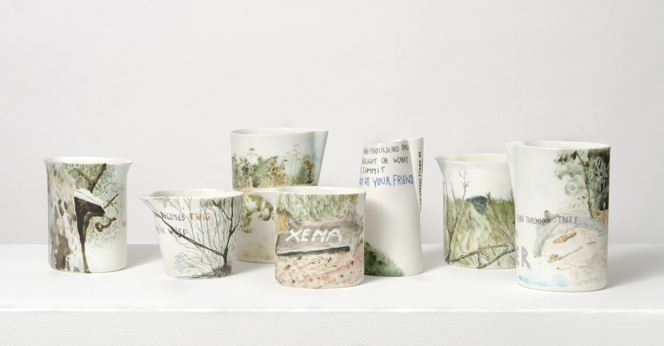
Figure 12: Poetry by Sarah Rice, ceramics by Patsy Hely, On the Mountain (seven painted porcelain vessels).
MS: Each collaborator (so far a dancer, a photographer, a book artist, a performance artist, a visual artist and a couple of musicians) has taught me something, inspired me to work in a new way, and drawn me well out of my ‘comfort zone’. To engage with another creative consciousness, converse with it and learn from it is an enormous privilege. It is wonderful to have companions on what is usually a solitary journey. Working with artists from other disciplines also helps me see the similarities between creative endeavours and to understand more clearly the ‘work’ of art in all its forms. Also for me the dislocations and translations involved in genre-crossing function as yet another fruitful form of creative disruption.
PG: I don’t claim I really make work in multiple art forms—but in response and in collaboration, yes, yes, yes. I have worked with painters, sculptors, letter-carvers, musicians of several kind, actors, dancers, puppeteers and in the world of mask-work. And with scientists too.
Why? The delight of being with people who experience the world in different ways from me—especially whose main way of negotiating with it was by some means other than words. Assuming that they and I can establish real trust with each other, I like feeling free to admire and enjoy the difference of what they do. In my keynote talk I spoke of cross arts collaboration as a difference engine; the difference, held across the space between you, gives that space its energy, and shape… I also like it when collaborators show me how to use some of their tools and materials (I love the feel of clay—now, there’s ‘material’!) and let me play…
Question 5: Ekphrasis v Translation: Discuss.
CF: I’ve always understood ekphrasis as an external exercise: looking at something and describing it. Translation seems more intimate, more of a process that moves into and through something: you don’t end up with a straight copy of the thing that is being translated, you end up with the artifact of an exploration, with something similar but slightly different. It’s all perception, either way. With ekphrasis you’re free to step sideways, to give out a lateral reaction to the original piece; with translation there is an obligation to keep a connection to the ‘meaning’ or ‘intention’ of the original. I think both work best when it’s cross-disciplinary; I always enjoy translations of ancient texts by poets rather than classicists, or reactions to paintings by musicians. Having said all that, I’m pretty loose with my own concept of translation. I will let a piece of paper carry the meaning of something a poem is trying to say, and not many people speak Paper…
SR: For me, ekphrasis goes beyond translation insofar as it is not a direct attempt to reproduce or re-enact the original—or even to remain faithful to it. What I enjoy about ekphrasis is there is no real original—to me the dialogue goes both ways, and each could stand on its own. The ekphrastic urge is more metaphorical and less mechanistic. It is not trying to match or reproduce or correspond exactly. Rather it is a way of finding some unnameable spirit, or force, or impulse, or yearning, or desire contained within the first medium, and allowing it to express itself with the lips and tongue and fingertips and heart of another medium—to walk around inside a new form—or to dance! It’s a way of ‘moving’ the pulse along (a chain of signifiers)—of being ‘moved’—of not becoming static.
MS: With translation, my ideal is fidelity to the effect of the original. I try very hard to convey its atmosphere to the speakers of the target language, even if this means choosing different imagery to achieve this. I do keep referring back to the original to ensure that the translation has not misrepresented it. With ekphrasis on the other hand, I feel much freer to use the original simply as a jumping-off point, and for the resulting poem to be a map of my own intellectual, emotional and artistic response rather than a representation of the original in any kind of faithful way. The process is different again if it is a collaboration, in other words if I am working with another creative person to make something that comes from both of us (or out of the active space between us, to borrow Philip’s phrase (Gross 2016: n.pag.) (see Figure 13)).
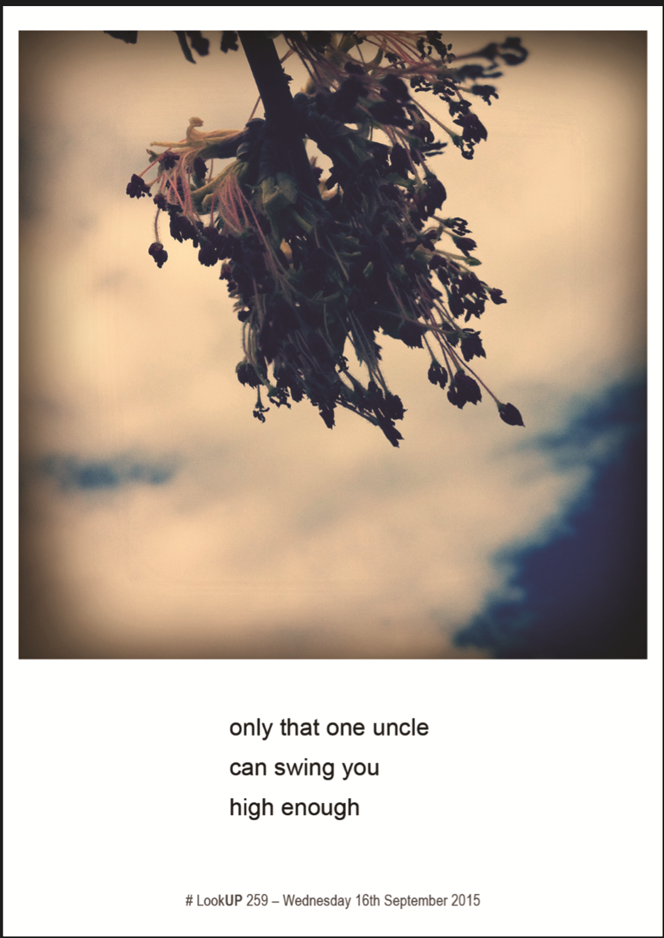
PG: I tend to handle the word ‘ekphrasis’ with a little scepticism, partly because those of us writers who do creative work in schools have known for years how fertile a starting point for new work, and how good a training ground for vivid observation, visual art can be. It is only quite recently that a term has been revived from ancient Greek to give this practice academic clout. Of course, the questions raised by writing with art go genuinely deep into the heart of the creative process, way beyond the Classical sense of reproducing someone else's well-known narrative in words as a training in rhetoric. I see no clear boundary between ekphrasis and translation… nor indeed between them and collaboration—notice the awkwardness with which, just now, I said ‘writing with’ as opposed to ‘about’. My real excitement is in working with and alongside artists, getting in and out of each other's process, making work that neither of us claims as ours alone.
Even when I am faced with a long done-and-dusted work of art, an Old Master or palaeolithic cave painting, the point is never for the words to restate, or to write a gloss upon, the picture, any more than the images are there to illustrate the words. Even there, the principles behind their meeting are of mutuality and equality. I have recently read (in fact, examined as a PhD) a bold argument that collaboration with the dead is a creative (I mean, not a supernatural) possibility.
And the key word, in the end, is conversation. I like working with artists in a way that each of us responds equally, and repeatedly, back and forth, to the other, until the final work emerges as if in its own right, in the space between.
Drucker, J 2011 ‘How Some Poems Are Made’ in Threads Talk Series www.writing.upenn.edu/pennsound/x/Threads.php (accessed 22 August 2016)
Gross, P 2016 ‘Together in the space between: collaboration as a window on creative process’, Axon: Creative Explorations C1
McGann, J J The Textual Condition, Princeton NJ: Princeton University Press
Whitman, W 1868 Selected Poems, ed. W M Rosetti, London: J C Hotten